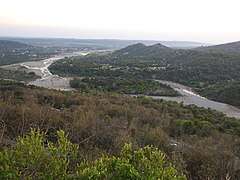Nurpur kingdom
Nurpur was a petty state in India from around the 11th century until it was annexed by the British East India Company in 1849. It covered an area of 180 square kilometres (69 sq mi) and is now part of Himachal Pradesh state. The ancient rulers of Nurpur patronised the Pahari painting style.
| Nurpur State | |||||||
|---|---|---|---|---|---|---|---|
| Princely State | |||||||
| 11th century–1849 | |||||||
| Area | |||||||
• 1901 | 180 km2 (69 sq mi) | ||||||
| Population | |||||||
• 1901 | 102289 | ||||||
| History | |||||||
• Established | 11th century | ||||||
• Annexation by the British East India Company | 1849 | ||||||
| |||||||
| Today part of | Himachal Pradesh, India | ||||||
| Imperial Gazetteer of India[1] | |||||||
The capital of Nurpur State was the town of Nurpur which had a population of 4,462 according to the 1901 Census of India.[1]
History
The state of Nurpur, originally known as Dhameri, was founded towards the end of the 11th century by Jhet Pal, who was the younger brother of the ruler of Delhi. It was ruled by of the Pathania dynasty, who claimed to be a branch of the Tomaras of Delhi.[2] Nurpur reached its peak between 1580 and 1613 during the reign of Raja Basu Dev who built an impressive fort that can still be seen today. The state became a feudatory state of the Mughal Empire and later resisted Sikh domination until it fell to Ranjit Singh in 1815. The state was annexed by the British East India Company in 1849. Raja Jaswant Singh Pathania, the last ruling monarch of Nurpur, was financially compensated by the British for the loss of his state.
The change of name from Dhameri to Nurpur came after it was visited by Queen Nur Jahan (1569–1627). According to the local legend, she was so impressed by the beauty and richness of the town that she decided to stay there for the rest of her life. This decision worried the administration of Dhameri for at that time the Mughal Empire was expanding across India and the local leaders did not want their peaceful town to be a central point for Mughal domination and subject to the influence of external politics. Therefore, to deal with this without offending the queen and suffering the wrath of the Mughal Empire, they devised a simple but effective plan. They advised the queen that staying in their town for a long period of time could spoil her great beauty because there was a fictitious local disease that might afflict her. This terrified the queen so much that she hurriedly left. Thus in 1622, the name of the town was changed to Nurpur in honour of the Mughal queen who had fallen in love with the beauty of the place.
Rajas
- ca. 1095 Raja Jhet Pal
- 12th century - 1313 Uncertain number of successors
- 1313 - 1353 Jas Pal
- 1353 - 1397 Kailas Pal
- 1397 - 1438 Nag Pal
- 1438 - 1473 Prithi Pal
- 1473 - 1513 Bhil Pal
- 1513 - 1558 Bakht Mal
- 1558 - 1580 Pahari Mal
- 1580 - 1613 Basu Dev
- 1613 - 1618 Suraj Mal
- 1618 - 1646 Raja Jagat Singh
- 1646 - 1661 Rajrup Singh
- 1661 - 1700 Mandhata Singh
- 1700 - 1735 Dayadatha
- 1735 - 1770 Fateh Singh
- 1770 - 1805 Prithvi Singh
- 1805 - 1815 Bhir Singh
- 1846 - 1849 Jaswant Singh (state annexed by the British) (d. 1898)
Gallery
 Entrance to the Nurpur Fort
Entrance to the Nurpur Fort Entrance to the Nurpur Fort
Entrance to the Nurpur Fort Nurpur fort ,inner view of ruin
Nurpur fort ,inner view of ruin View of Ravi river from Nurpur fort
View of Ravi river from Nurpur fort
See also
References
- Imperial Gazetteer of India, v. 19, p. 232.
- Brentnall, Mark (2004). The Princely and Noble Families of the Former Indian Empire: Himachal Pradesh. 1. Indus Publishing. pp. 350–358. ISBN 978-8-17387-163-4.
- "Indian Princely States K-Z". www.worldstatesmen.org. Retrieved 31 August 2019.
![]()